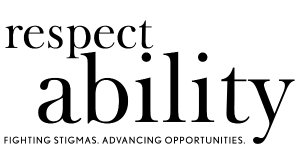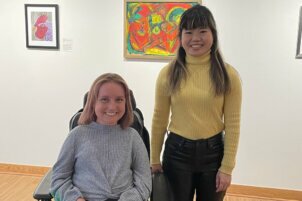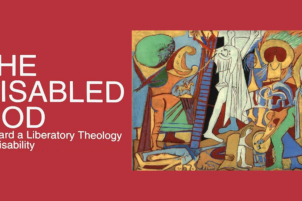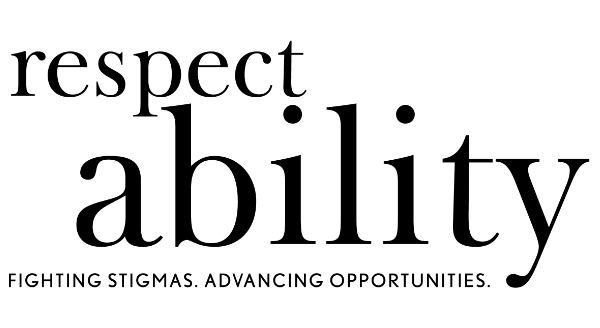What does the Lord require of you but to do justice, and to love kindness, and to walk humbly with your God. Micah 6:8.
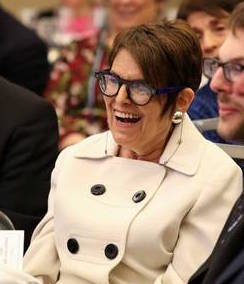
Rabbi Lynne Landsberg at the 2017 Tzedek dinner for the Religious Action Center of Reform Judaism’s Consultation on Conscience. Photo by Ralph Alswang, courtesy of Rabbi Landsberg and the Religious Action Center.
The Talmud [Berachot 34b] teaches that one must pray in a house with windows so they can see the heavens and focus their heart. Rabbi Lynne Landsberg, of blessed memory, was the Senior Advisor on Disability Rights at the Religious Action Center for Reform Judaism (RAC). As a passionate advocate for disability rights, she wrote, “the Talmud teaches us that a synagogue must be built with windows in the sanctuary. I believe this is so we can see who is outside and unable to join us.”
Thirty-two years ago, on July 26, 1990, the Americans with Disabilities Act (ADA) was signed into law by President George H.W. Bush. The ADA is a comprehensive federal civil rights statute that protects the rights of people with disabilities, entitling over 56 million Americans with disabilities to equal opportunities as full citizens of the United States. The ADA is landmark legislation for many people who, prior to its passage, couldn’t cross the street in their wheelchair, use the restroom in public buildings, or ride public transportation.
Faith institutions are covered by Title I employment regulations in the case of organizations with 15 or more employees. They are also covered by Title III if space is rented to an outside organization, such as a daycare that is not owned or operated in any way by the faith organization. But other than with these two cases, faith institutions are exempted from the ADA.
Although some religious groups tirelessly advocated for the passage of the ADA, many others opposed it. The Dole Archive Collections at Kansas University houses a virtual time capsule of documents surrounding the exemption of religious organizations. A White House memorandum, dated July 17, 1989, nearly a full year before the ADA was signed into law, argued that “entirely exempting religious organizations in the ADA is well-advised as a matter of constitutional law and is preferable as a matter of constitutional policy.” The memo concluded: “The ADA would impose extensive requirements on religious organizations. There is no indication that these requirements are at all necessary, for the evidence does not establish that religious organizations discriminate against Americans with disabilities. In fact, we believe the evidence points the other way.”
More than three decades later, evidence shows that people with disabilities still face discrimination in faith communities with alarming frequency. Stigma, stereotypes, and misinformation are obstacles that perpetuate ableism and othering, thus shutting people out.
According to the Collaborative on Faith and Disabilities, 84 percent of people with disabilities say their faith is important to them, but only 45 percent of people with disabilities attend a place of worship at least monthly. Only ten percent of faith communities do congregation-wide disability awareness programs or events. 32 percent of parents changed their place of worship because their child with a disability was not included or welcomed.
While in most cases the ADA does not legally mandate inclusion in faith institutions, the ADA can serve as a moral mandate for faith communities to draw upon. The regulations offer specific guidance on how to improve access to buildings and grounds as well as how to make programs and employment opportunities accessible to people with disabilities.
And the ADA does not stand alone as a moral mandate. Biblical texts can provide another kind of guidance, one that opens hearts as well as minds, causing us to question attitudes and beliefs about how people with disabilities are regarded, treated, and valued. Throughout the Tanakh (Hebrew Bible), we encounter people with lived experiences of disability. Moses, who lived with a speech disability, was appointed by God to advocate for freedom for the Israelites from the Egyptians. He lead them to the land God promised to Abraham. When Moses resisted taking on this enormous responsibility because of his speech disability, God provided the first known accommodation, Aaron, to be Moses’ voice. The legacy of Moses is to ensure that all people are accepted, included, and supported in religious and spiritual community.
In 2020, the pandemic shut down in-person gatherings in many religious organizations. Churches, synagogues, mosques, temples, and other religious entities were challenged to find ways for people to access their offerings.
Zoom became the platform for many virtual sanctuaries and gathering places. Adjacent technologies such as live captioning became exceedingly important for accessibility. Despite the exemption from the ADA, faith communities created reasonable accommodations in the form of universal design by opening virtual doors to participation. They offered opportunities to practice one’s religion, engage spirituality in community, and feel a sense of belonging. On Zoom, our sanctuaries were actual windows. We saw faces and names.
Now, houses of worship and religious organizations must maintain accessibility as they return in-person. The invitation to belong was issued and accepted, and there are no takebacks.
Rabbi Landsberg, who championed inclusion and access, implored houses of worship to ask themselves if they are doing all they can to ensure that people with disabilities have access to all aspects of faith community life. She wrote, “the ADA mandates access to public buildings but, as I have long said, it cannot mandate access to the human heart.” In the disability rights community, the old saying goes, “before ramping buildings, you have to ramp attitudes.”
Although Americans celebrate the 32nd anniversary of the ADA on July 26, there is still significant work to be done. Disabled people of faith and those who love them require more than open sanctuary windows to feel they belong. In the spirit of the law, we can turn good intentions into actions that open doors and create attitudinal changes.
